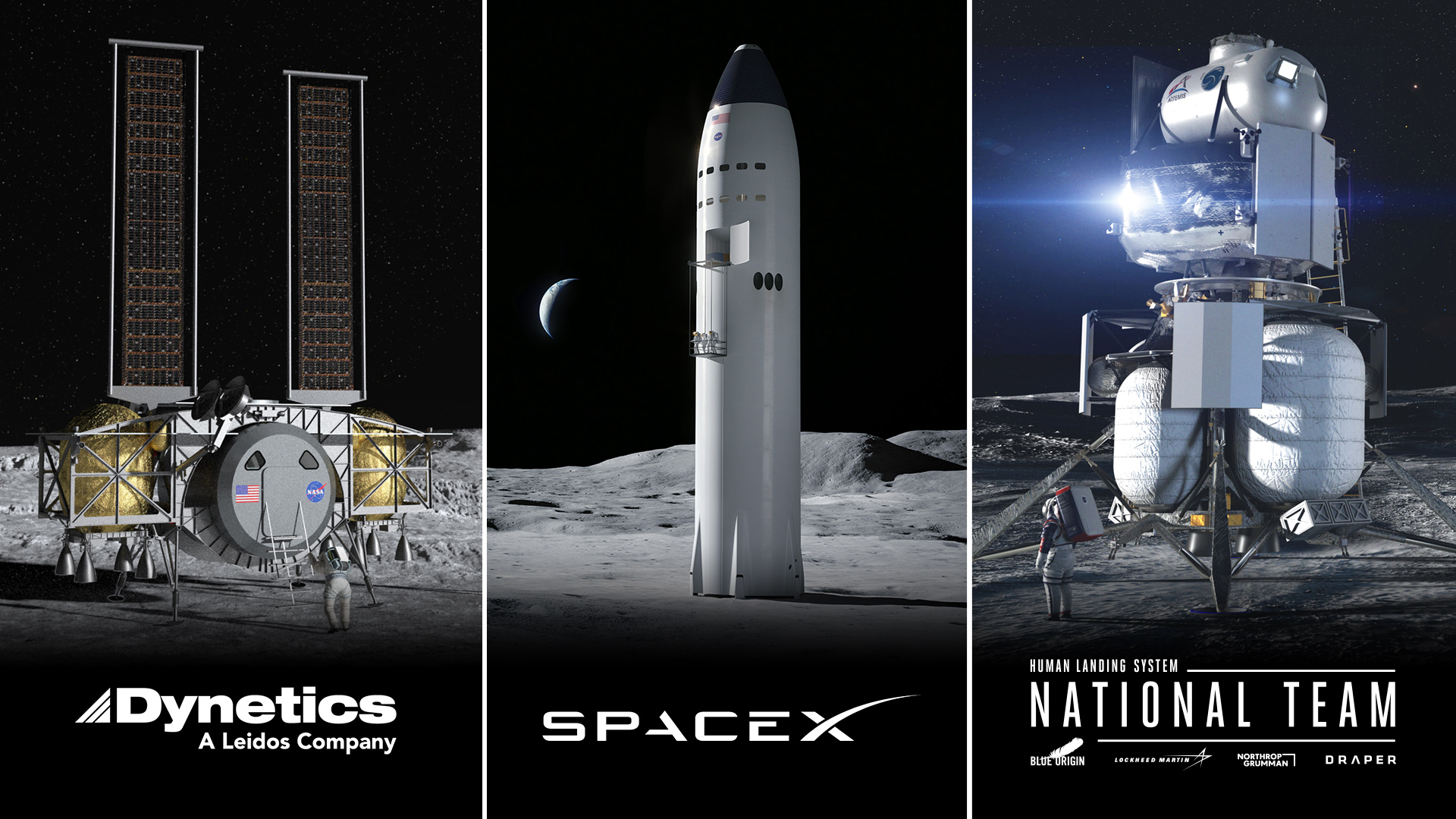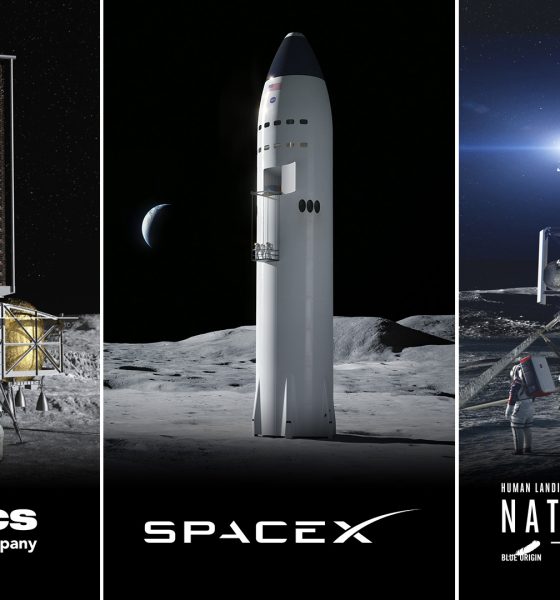

News
SpaceX’s Starship Moon lander passes NASA review alongside Blue Origin, Dynetics
A variant of SpaceX’s Starship spacecraft optimized to land NASA astronauts on the Moon has passed the space agency’s first review alongside competing teams lead by Blue Origin and Dynetics.
Aside from reiterating the fact that NASA is drawing heavily from its experience with the Commercial Crew Program (CCP), the completion of “certification baseline reviews” for Blue Origin, Dynetics, and SpaceX’s proposed lunar landers is a significant step forward for the Human Landing System (HLS) and Artemis programs. According to NASA’s official HLS “Broad Agency Announcement” or BAA, providers must submit a vast amount of paperwork and data to pass the certification baseline review (CBR).
NASA’s acceptance criteria for CBR documentation is about as general as the space agency gets, requiring providers to demonstrate at least a basic level of maturity and expertise. Like the name suggests, it sets a baseline from which NASA and SpaceX, Dynetics, and Blue Origin’s National Team will hone in on challenges and concerns specific to each system. SpaceX’s proposal is almost certainly unique, however, given that the company is the only one anywhere close to performing actual flight tests of a (relatively) similar system.

After much fanfare, NASA finally revealed its first real Human Landing System contracts on April 30th, 2020, awarding funds to Blue Origin, Dynetics, and SpaceX to develop three extremely dissimilar Moon landers. Designed to ferry NASA astronauts from a deserted lunar orbit (near-rectilinear halo orbit, NRHO). NASA initially refused to delineate the distribution of the $967 million contract.

Several news outlets later reported that Blue Origin’s “National Team” (including Draper, Lockheed Martin, and Northrop Grumman) received $567 million to develop a complex three-stage system, using Blue Origin’s existing Blue Moon lander work for the final descent stage and lander. Dynetics won $253 million to build a slightly more familiar single-stage lander and SpaceX received $135 million for a single-stage Starship-derived vehicle.
The main goal of NASA’s initial funding is to extensively characterize and understand the capabilities and characteristics of each proposal and the likelihood that each vehicle will actually be ready to land humans on the Moon by the end of 2024. The next major HLS milestone will be what the space agency calls a “continuation review,” in which NASA will likely downselect to one of the three landers above. Administrator Jim Bridenstine says that NASA may decide to proceed with more than one provider but the strong implication is that only one will exit the ~December 2020 continuation review with future funding.


For SpaceX, it appears that the company will almost certainly field an orbit-capable Starship and Super Heavy booster with or without external help. At this point in the program, it would take a major upset for SpaceX not to be ready to start orbital Starship launch attempts in 2021. To an extent, SpaceX has proven through Falcon 9, Falcon Heavy, and Crew Dragon that it’s capable of developing reliable, reusable, industry-leading rockets and spacecraft several times more cheaply than its closest competitors.
To build a Starship safe and reliable enough that SpaceX can convince NASA to land astronauts on the Moon with it, the company will effectively have to prove that it can cut the cost of rocket production by another factor of five or ten. Time will tell where NASA’s HLS cards fall just a few months from now.
Check out Teslarati’s Marketplace! We offer Tesla accessories, including for the Tesla Cybertruck and Tesla Model 3.

News
Tesla FSD fleet is nearing 7 billion total miles, including 2.5 billion city miles
As can be seen on Tesla’s official FSD webpage, vehicles equipped with the system have now navigated over 6.99 billion miles.

Tesla’s Full Self-Driving (Supervised) fleet is closing in on almost 7 billion total miles driven, as per data posted by the company on its official FSD webpage.
These figures hint at the massive scale of data fueling Tesla’s rapid FSD improvements, which have been quite notable as of late.
FSD mileage milestones
As can be seen on Tesla’s official FSD webpage, vehicles equipped with the system have now navigated over 6.99 billion miles. Tesla owner and avid FSD tester Whole Mars Catalog also shared a screenshot indicating that from the nearly 7 billion miles traveled by the FSD fleet, more than 2.5 billion miles were driven inside cities.
City miles are particularly valuable for complex urban scenarios like unprotected turns, pedestrian interactions, and traffic lights. This is also the difference-maker for FSD, as only complex solutions, such as Waymo’s self-driving taxis, operate similarly on inner-city streets. And even then, incidents such as the San Francisco blackouts have proven challenging for sensor-rich vehicles like Waymos.
Tesla’s data edge
Tesla has a number of advantages in the autonomous vehicle sector, one of which is the size of its fleet and the number of vehicles training FSD on real-world roads. Tesla’s nearly 7 billion FSD miles then allow the company to roll out updates that make its vehicles behave like they are being driven by experienced drivers, even if they are operating on their own.
So notable are Tesla’s improvements to FSD that NVIDIA Director of Robotics Jim Fan, after experiencing FSD v14, noted that the system is the first AI that passes what he described as a “Physical Turing Test.”
“Despite knowing exactly how robot learning works, I still find it magical watching the steering wheel turn by itself. First it feels surreal, next it becomes routine. Then, like the smartphone, taking it away actively hurts. This is how humanity gets rewired and glued to god-like technologies,” Fan wrote in a post on X.
News
Tesla starts showing how FSD will change lives in Europe
Local officials tested the system on narrow country roads and were impressed by FSD’s smooth, human-like driving, with some calling the service a game-changer for everyday life in areas that are far from urban centers.

Tesla has launched Europe’s first public shuttle service using Full Self-Driving (Supervised) in the rural Eifelkreis Bitburg-Prüm region of Germany, demonstrating how the technology can restore independence and mobility for people who struggle with limited transport options.
Local officials tested the system on narrow country roads and were impressed by FSD’s smooth, human-like driving, with some calling the service a game-changer for everyday life in areas that are far from urban centers.
Officials see real impact on rural residents
Arzfeld Mayor Johannes Kuhl and District Administrator Andreas Kruppert personally tested the Tesla shuttle service. This allowed them to see just how well FSD navigated winding lanes and rural roads confidently. Kruppert said, “Autonomous driving sounds like science fiction to many, but we simply see here that it works totally well in rural regions too.” Kuhl, for his part, also noted that FSD “feels like a very experienced driver.”
The pilot complements the area’s “Citizen Bus” program, which provides on-demand rides for elderly residents who can no longer drive themselves. Tesla Europe shared a video of a demonstration of the service, highlighting how FSD gives people their freedom back, even in places where public transport is not as prevalent.
What the Ministry for Economic Affairs and Transport says
Rhineland-Palatinate’s Minister Daniela Schmitt supported the project, praising the collaboration that made this “first of its kind in Europe” possible. As per the ministry, the rural rollout for the service shows FSD’s potential beyond major cities, and it delivers tangible benefits like grocery runs, doctor visits, and social connections for isolated residents.
“Reliable and flexible mobility is especially vital in rural areas. With the launch of a shuttle service using self-driving vehicles (FSD supervised) by Tesla in the Eifelkreis Bitburg-Prüm, an innovative pilot project is now getting underway that complements local community bus services. It is the first project of its kind in Europe.
“The result is a real gain for rural mobility: greater accessibility, more flexibility and tangible benefits for everyday life. A strong signal for innovation, cooperation and future-oriented mobility beyond urban centers,” the ministry wrote in a LinkedIn post.
News
Tesla China quietly posts Robotaxi-related job listing
Tesla China is currently seeking a Low Voltage Electrical Engineer to work on circuit board design for the company’s autonomous vehicles.

Tesla has posted a new job listing in Shanghai explicitly tied to its Robotaxi program, fueling speculation that the company is preparing to launch its dedicated autonomous ride-hailing service in China.
As noted in the listing, Tesla China is currently seeking a Low Voltage Electrical Engineer to work on circuit board design for the company’s autonomous vehicles.
Robotaxi-specific role
The listing, which was shared on social media platform X by industry watcher @tslaming, suggested that Tesla China is looking to fill the role urgently. The job listing itself specifically mentions that the person hired for the role will be working on the Low Voltage Hardware team, which would design the circuit boards that would serve as the nervous system of the Robotaxi.
Key tasks for the role, as indicated in the job listing, include collaboration with PCB layout, firmware, mechanical, program management, and validation teams, among other responsibilities. The role is based in Shanghai.
China Robotaxi launch
China represents a massive potential market for robotaxis, with its dense urban centers and supportive policies in select cities. Tesla has limited permission to roll out FSD in the country, though despite this, its vehicles have been hailed as among the best in the market when it comes to autonomous features. So far, at least, it appears that China supports Tesla’s FSD and Robotaxi rollout.
This was hinted at in November, when Tesla brought the Cybercab to the 8th China International Import Expo (CIIE) in Shanghai, marking the first time that the autonomous two-seater was brought to the Asia-Pacific region. The vehicle, despite not having a release date in China, received a significant amount of interest among the event’s attendees.








